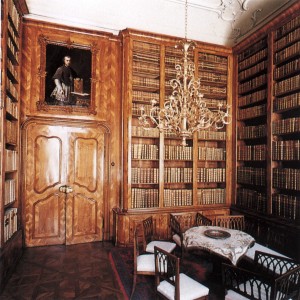Első ünnepi könyvvásár
Tájékoztatók az első ünnepi könyvvásárról ITT.
 The 65,000 volume stock of the Veszprém Archiepiscopal Library consists of the jointly managed collection of the Episcopal Library, the Chapter Library and the Seminary Library. It received its new name after promoting the Veszprém diocese to a level of archdiocese in 1993.
The 65,000 volume stock of the Veszprém Archiepiscopal Library consists of the jointly managed collection of the Episcopal Library, the Chapter Library and the Seminary Library. It received its new name after promoting the Veszprém diocese to a level of archdiocese in 1993.
The Episcopal Library was founded by bishop Márton Padányi Biró. Márton Biró was the pastor of the Veszprém diocese from 1745 to 1762. He governed his diocese from the episcopal residence he built in Sümeg. He was a learned and literate person. He decided to establish a library in his palace in Sümeg. In this far-seeing job he was largely assisted by clergyman István Tessedik, his commissioner in Vienna. The collection of 607 volumes were compiled shortly, the second half of the year 1751 was the time of stock-taking. Every book has a handwritten possessor’s record. Ex libris Márton Padányi Bíró Veszprém bishop, 1751. Its inventory lists the titles in thematic classification. They were located in style in a room next to the chapel of the episcopal residence.
His successor, Ignác Koller (1762–1773) has the Veszprém episcopal palace planned, he establishes a library room with artistic furniture upstairs in the northern wing for the 1671 volumes he purchased.
Károly Hornig paid special attention to the improvement of the library. He occupied his episcopal see in 1888 and he was promoted to a cardinal by pope Pius X in 1912. His booksellers in Vienna and Budapest informed him about the news of the book market. He himself did all the work related to his library and books. The stock was taken in the inventory after his death, and it included 17346 volumes. This stock forms the backbone of the Episcopal/Archiepiscopal Library.
Nándor Rott, Veszprém bishop between the two world wars, solved the joint management of the collections of Márton Biró, Ignác Koller and Károly Hornig by appointing master of ceremony Róbert Schwartz to librarian in 1928. As a result of careful work, the authors’ and subject catalogues were created. The adverse conditions of the chapter and seminary libraries after the war justified the joint management of the three libraries. The library keeps the valuable music musical notes collection of the cathedral containing musical documents from the 18–19th centuries. The focus of interest for most of the researchers are the local studies. Processing takes place in the Corvina Integrated Library System. The library is available for researchers and readers as a public library in the opening hours.
Tájékoztatók az első ünnepi könyvvásárról ITT.
Copyright © 2025. All rights reserved.